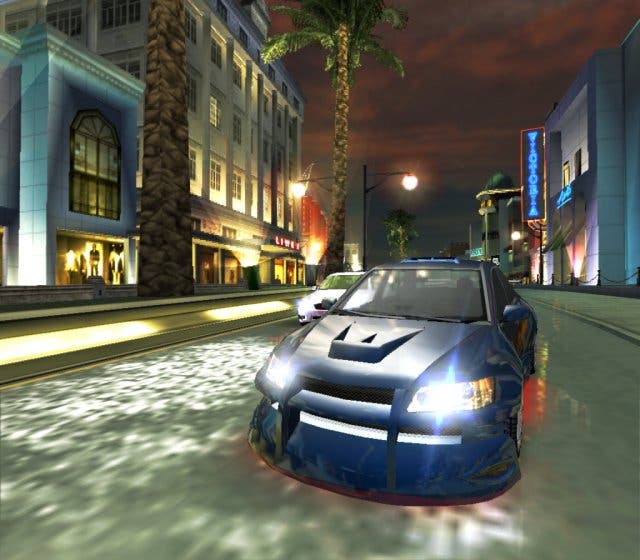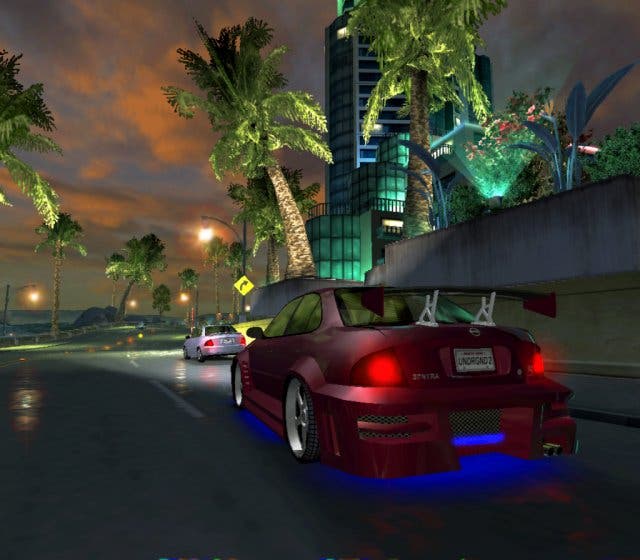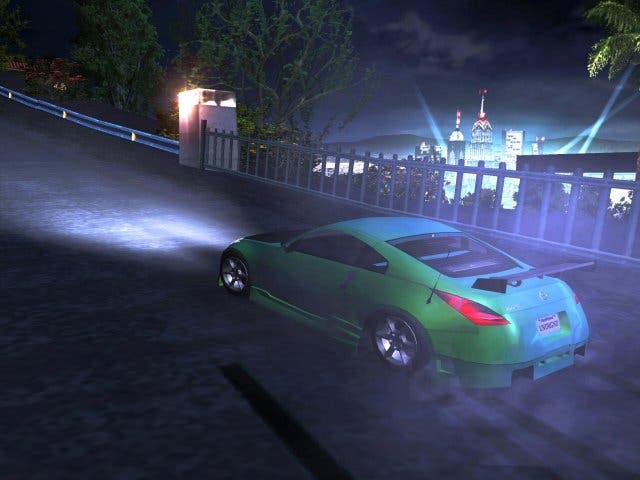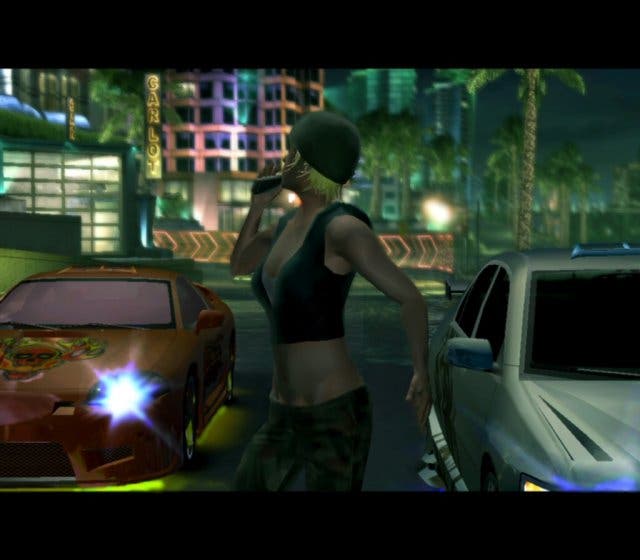Need For Speed Underground 2 Review
A dashboard confessional for a guilty pleasure.
However discerning we like to think we are, there are times when guilty pleasures barge our resolutely held principles out of the way like a bowling ball through skittles. It's a little harder to have too many contrary opinions as a game reviewer, when every mildly differing score seems to turn into a witch-hunt. God forbid that anyone should have a difference of opinion eh? So, as much as it'd be the easiest thing in the world right now to reel off a one thousand word diatribe against Need For Speed Underground 2, bloody EA has gone and confounded expectations yet again.
Pretend we're dead

You see, as imbecilic as this game ought to be, and as much of a deep insult to anyone's intelligence as the whole concept is, it's just too much fun to consign it to the slag heap. It's the trashy pop song you hum to yourself uninhibitedly in the shower, or the rank reality TV show you can't switch off. It's addictive. Maddeningly so. Yet also so obviously complete rubbish in the context of 'proper' racing games. So how come we're so hopelessly compelled to play it non-stop for hours? Howling abuse at the screen at the blatantly cheating elastic AI, desperate for someone with a design brain to shake the flaws out of this nearly brilliant game. Wincing at the Day-Glo neon gaucheness, blinded by the baby oil sheen on the roads and terrible weather effects. Cursing the dreadful handling and wishing we didn't have to drive around this preposterously designed spaghetti junction cityscape using GPS tracking just to fathom how to get to your destination. You'd think all these things would have us running for the 'off' switch faster than a leaping head crab in City 17. But we don't. We keep playing. We pimp up our ride. We race some more. What's wrong with us?
And what's more confusing is that the game's actually even moreirritating than last year's surprise hit. At least the original Underground has some actual design sensibilities, allowing gamers to simply start a race. You know, from a menu, unlocking several at a time to allow a semblance of non-restrictive choice. In most senses, this year's sequel is exactly the same, except it's maddeningly bolted on a GTA-style city-based approach, giving players the slightly pointless choice of driving to each and every one of the races on offer before you can get going (pointless given you can skip straight to the garage and access them directly). The idea of letting you get to grips with a street racing game by letting the player, um, drive around 'da streets, innit' might sound like a great new free-roaming feature to slap on the box, but in practice it plainly just makes the process of doing very simple things tedious. But still we play on. And on.
Lovin' it...

Another faintly ludicrous idea that shouldn't work is making the driving experience as unenjoyable as possible for the first five hours. The premise of building your street racing career from hungry young rookie to the king of the streets is a noble one, but not when the reality of lurching around in a crappy Peugeot 106 is about as much fun as racing a milk float (in fact that might have been more fun just for the comedy value). Not until you've won about two dozen races do you have a specced up car worthy of the name, and by then you'll have already sunk several hours into the game. Racing old bangers isn't really the reason people buy into these games is it? Sure, you can overcome adversity and eventually drive down the Body Shop and buy all manner of performance-related upgrades, but getting there is a chore. A trial. Relentless. Repetitive. And still we keep playing. Almost exclusively to find out if the game gets good once we can actually get some this speed that we evidently need.
As with Burnout 3, the presentation's slick, savvy, but also at times unbearably cheesy, full of the worst kind of American cool that turns mild mannered Europeans into frothing axe-wielding psychopaths in a matter of a few badly chosen moments of ill-advised exuberance such as "get out there and go savage, bro" or something else involving cabbages, of all things. As you might expect, the tutorial process goes on and on, as with a lot of EA games, with many well-timed video clips to show you the ropes and an endless succession of SMS-style messages delivered to keep you informed of unlocks, tips and events going on around the cities. It's hard to knock the intentions of what it's trying to do; it's just this sort of corporate soullessness to the delivery that gets under our skin. This perception of cool from suited teams of marketing drones is enough to drive anyone with a brain crazy. But still we play. EA are the McDonalds of games. You know you shouldn't like them, but they have this way of fooling our brains into believing that it's tasty goodness that you're busy consuming with that 1,000 yard stare fixed across your gaping head. Need For Speed Underground 2 is the Super Size Me of the racing world. After a month it might do irreparable harm to your vital organs. Don't try this at home.
Deeper underground

Okay, we'll try and refrain from kicking this addictive guilty pleasure any more than necessary. You get the picture. When you boil it down, NFSU2 hasn't moved on a huge amount since the original; essentially it's a super-sized NFSU based in a free-roaming city environment, now with added Xbox Live support (huzzah). So, to recap, there are multiple race types (Drift, Sprint, Drag, Circuit, Street X, and Underground Racing League), a vast number of performance upgrades (Engine, Tyres, Nitro, Brakes, Turbo, Weight Reduction, Hydraulics, Fuel System, Suspension, etc), not to mention the rather pointless, yet entirely integral visual mods (decals, rims, exhaust tips, paint, hoods, spoilers, audio, you name it). To anyone familiar with last year's version it's exactly the same drill: enter race, win race, win cash, spend cash on pimping your ride. As before, you soon catch the eagle eyes of sponsors, and soon you'll be raking in more cash, on the proviso you fulfil the terms of their contract - in other words enter a set number of URL races, another fixed number of races of your choosing from around the city, as well as getting your car on the front cover of various magazines (essentially won by making it from A to B within a time limit).
So, yes, the city freedom does allow a much greater sense of being able to do the game in the order of your choosing (and may well reduce frustration by allowing you to come back to failed races once you have a better car, and/or have specced up your existing one), and gradually a sense of there being a more coherent world does trickle down as you begin to familiarise yourself with the surroundings. But. But, the bottom line is the repetition factor does kick in eventually. There's only so much a gamer can take of doing roughly the same thing over and over and over again, against slightly more challenging opponents - especially with an execrable EA Trax/Crapx soundtrack largely consisting of the kind of teeth-grinding angst rawk that the 'kids' make 'cool' hand signals to during games like this (Queens Of The Stone Age aside, which can happily join us for tea anytime). The odd bit of techno and rap didn't help its cause, either.
Shine on

In terms of the actual race modes available, Drag has been bizarrely made less interactive than before, giving the player only the task of gear shifting and changing lanes, with actual steering AI controlled for reasons not fully apparent to us. Drift dispenses with any requirement to actually win the race at all (or finish for that matter) so long as you rack up enough drift points for powersliding your way around the course, which seems plain daft to us. Sprint is simply a charge to the finish line, Circuit predictably involves lap-based races against five opponents, Street X is a more aggressive, shorter version of Circuit that's all about barging your opponent off the racing line, while Underground Racing League is another non-street-based circuit racing variant that takes place over a series or longer, smoother racing tracks devoid of traffic.
All the modes included are reasonably entertaining, don't get us wrong, but as with more or less every single race mode included, the bastard, cheating, Satan's spawn AI makes winning races much more of a lucky break than the result of actual skill. Yet again, EA has made it possible for you to race the (almost) perfect race, slip up inexplicably at the final stretch and lose. Winning, it seems, is far from an exact science. Naturally you'll always win if you race perfectly, but yet there's always the sense that the game neither lets you get too far ahead, nor too far behind - hence the omnipresent fear that the AI is always there, lurking, ready to pounce on unfathomable mistakes. It's just excruciatingly frustrating that rather than simply set a sort of time-based requirement where meeting that time will win you the race, EA has again opted for a system whereby coming second in one race can be clocked in at, say 5 minutes, yet 4.40 in the next race could also quite feasibly net you second - all because the AI's tracking you like a hawk, whether scorching along in first or lagging in fourth. EA, if only you could mend this nonsensical system there might be a game here really worth recommending to all.
But even if that were the case, there's still the issue of the unsatisfying handling and the way it looks. Firstly on the latter point, we all know EA can make fine looking games, and to an extent NFSU2 looks bloody marvellous, with the neon skyline view from the hills truly spectacular. The cars certainly looks great (although can't be damaged, somewhat pointlessly, no doubt thanks to those oh-so tedious licensing restrictions), and the actual quality of the scenery is unquestionably top notch. It's just the way the whole thing's sugar coated in Voodoo 2 lens flare neon circa-1998and subsequently doused in patently ludicrous Johnson's Baby Oil sheen. Looking back a few years ago to Need For Speed games such as the wonderful Hot Pursuit on the PC there was no doubt EA had one of the best racing game engines going. But what the hell's happened to the art direction since then? It's wrapped up in psychedelic airbrushed madness, where EA's vision of street racing has somehow met up with and rigorously fornicated with Athena poster designers from 1984. We want out of this surreal nightmare now. Our eyes cannae take it anymore.
Craving for misbehaving
But yet for all the camp pastel slipperiness, we still kept playing. If we weren't tasked with reviewing such a commercially gigantic game, we'd probably never tell a soul that it was possible to enjoy a Need For Speed Underground game, never mind its bastard offspring. And that's the maddening, messed up thing about all this. Despite all evidence to the contrary, we really did somehow glean an unlikely amount of enjoyment out of this hysterically warped piece of racing game design. Maybe the trick is that EA knows it doesn't make any sense either. It just knows there's a demand for this stuff. Like terrifyingly addictive bad things like cigarettes, fast food and trash TV, you can't help but get sucked in by it all. Weird creatures, human beings. Always enjoying the wrong things, despite themselves.

